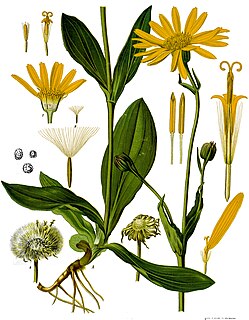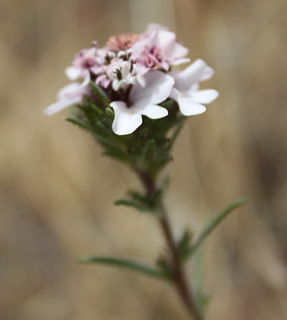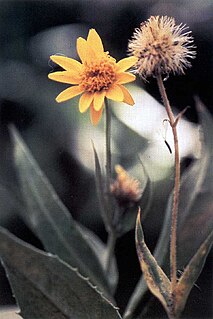
Arnica is a genus of perennial, herbaceous plants in the sunflower family (Asteraceae). The genus name Arnica may be derived from the Greek arni, "lamb", in reference to the plants' soft, hairy leaves. Arnica is also known by the names mountain tobacco and confusingly, leopard's bane and wolfsbane—two names that it shares with the entirely unrelated genus Aconitum.

Geraea viscida is a species of flowering plant in the daisy family known by the common name sticky geraea, or sticky desertsunflower. It is native to southern California, mainly the chaparral hills of eastern San Diego County, and nearby Baja California.
Hulsea nana is a North American species of flowering plant in the daisy family known by the common name dwarf alpinegold. It is native to the western United States from Washington, Oregon, and far northern California.
Arnica cernua is a species of arnica known by the common name serpentine arnica. It is native to the Klamath Mountains of northern California and southern Oregon, where it is a member of the serpentine soils flora.

Arnica discoidea is a North American species of arnica in the sunflower family. It is known by the common name rayless arnica because its flower heads have disc florets but none of the showier ray florets. It is native to the woodlands, forests, and chaparral of the western United States (Washington, Oregon, California, and western Nevada.

Arnica fulgens is a species of arnica known by the common names foothill arnica and hillside arnica. It is native to western North America, from British Columbia east to Saskatchewan and south as far as Inyo County, California, and McKinley County, New Mexico. It grows in open, grassy areas.

Arnica latifolia is a species of arnica in the sunflower family, known by the common names broadleaf arnica, broad leaved arnica, mountain arnica, and daffodil leopardbane. It is native to western North America from Alaska east to Northwest Territories and south to Mono County, California, and Taos County, New Mexico. It grows in mountain habitat such as forest and meadows.

Arnica mollis is a North American species of arnica in the sunflower family, known by the common name soft arnica, or hairy arnica. It is native to Canada and the United States (Alaska and the western mountains as far south as San Bernardino County, California and Rio Arriba County, New Mexico. There are also isolated populations in the White Mountains of Coos County, New Hampshire. The species grows in subalpine mountain habitat such as meadows and streambanks.

Arnica nevadensis is a North American species of arnica in the sunflower family, known by the common names Nevada arnica and Sierra arnica. It is native to the coniferous forests of the western United States, primarily the Cascades and Sierra Nevada.

Arnica sororia is a North American species of arnica known by the common name twin arnica. It is native to western Canada and the western United States. It grows in grasslands and in conifer forests.
Arnica spathulata is a rare North American species of arnica in the sunflower family, known by the common name Klamath arnica. It is native to the Klamath Mountains of northwestern California and southwestern Oregon. It grows in woodland habitat, almost exclusively on serpentine soils.

Arnica venosa is a rare California species of arnica in the sunflower family known by the common name Shasta County arnica. It should not be confused with the Mt. Shasta arnica, A. viscosa.
Eucephalus breweri is a North American species in the aster family known by the common name Brewer's aster. It is native to California where it grows primarily in the Sierra Nevada at subalpine elevations. Its range extends into northwestern Nevada and southwestern Oregon.
Calycadenia fremontii is a species of flowering plant in the daisy family known by the common name Frémont's western rosinweed. It is native to southwestern Oregon and northern California. It is a common member of the flora in several types of habitat in the mountains, foothills, and valleys. This annual plant is variable in appearance.

Calycadenia multiglandulosa is a species of flowering plant in the sunflower family, known by the common names sticky calycadenia and sticky western rosinweed. It is endemic to California, where it is a common in the Coast Ranges and in the Sierra Nevada Foothills from Shasta County to Kern County.

Chaenactis suffrutescens is a species of flowering plant in the aster family known by the common name Shasta chaenactis.
Erigeron petrophilus is a species of flowering plant in the daisy family known by the common names rockloving erigeron or cliff fleabane. It is native to the mountain ranges of California from Siskiyou County south as far as San Luis Obispo County and El Dorado County. It also grows in southwestern Oregon.

Arnica dealbata is a species of Californian plants in the tarweed tribe within the aster family
Agnorhiza ovata is a species of flowering plant known by the common name southern mule's ears. It is native to the mountains and foothills of southern California and Baja California, occurring the Coast Ranges and Sierra Nevada foothills in Tulare, Kern, Ventura, Los Angeles, Orange, Riverside, and San Diego counties in California, with additional populations in the Peninsular Ranges south of the international border.

Arnica lanceolata is a North American species of arnica in the sunflower family, known by the common name clasping arnica or lanceleaf arnica. It has a disjunct (discontinuous) distribution in western North America and northeastern North America.












